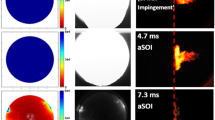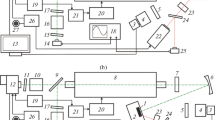Abstract
Optical methods in infrared (IR) and visible (VIS) ranges for detection of combustion zone propagation in solid high-energy materials, such as pyrotechnic compositions inserted into pyrolytic graphite (pyrographite) tubes and ignited at one end by a CO2 laser beam are presented. The pyrographite tube is used as a thermal management transducer enabling detection of combustion zone movement because of unique thermal conductivity anisotropy of pyrographite resulting in low thermal conductivity of the tube along its axis and high thermal conductivity along the tube radius. In the first method, an IR thermal camera is applied for detection of heat zone movement induced on the external side surface of the pyrographite tube by the combustion zone travelling inside the tube. According to the second method, a VIS camera and a thermochromic layer covering the external side surface of the pyrographite tube are used for visualization of heat zone movement registered as the color change boundary traveling along the thermochromic layer. The change in color of this layer is caused by its thermochromic substance response to heat delivered by the heat zone. As thermochromic substances, leuko dyes or chiral-nematic liquid crystals are used. These methods seem to be particularly promising for continuous measurements of burning rates of solid high-energy materials, such as solid rocket propellants and pyrotechnic compositions.
Similar content being viewed by others
References
G. G. Shelukhin, V. F. Buldakov, and V. P. Belov, “Experimental Study of Combustion of Condensed Systems,” Fiz. Goreniya Vzryva 5(1), 42–51 (1969).
Yu. V. Rozhdestvenskii, “Method and Technique of Studying Combustion Processes in Rocket Engines,” in Rocket Propellants, Ed. by Ya. M. Paushkin and A. Z. Chulkov (Mir, Moscow, 1975), pp. 171–187 [Russian translation].
V. A. Arkhipov, S. S. Bondarchuk, and A. G. Korotkikh, “Comparative Analysis of Methods for Measuring the Transient Burning Rate. I. Research Methods,” Fiz. Goreniya Vzryva 46(5), 82–87 (2010) [Combust., Explos., Shock Waves 46 (5), 564–569 (2010)].
V. A. Arkhipov, S. S. Bondarchuk, and A. G. Korotkikh, “Comparative Analysis of Methods for Measuring the Transient Burning Rate. II. Research Results,” Fiz. Goreniya Vzryva 46(5), 88–96 (2010) [Combust., Explos., Shock Waves 46 (5), 570–577 (2010)].
N. Eisenreich, H. P. Kugler, and F. Sinn, “An Optical System for Measuring the Burning Rate of Solid Propellant Strands,” Propel., Explos., Pyrotech. 12(2), 78–80 (1987).
M. Miszczak, A. Panas, and W. Swiderski, “A New Method for Continuous Measurements of Solid Rocket Propellant Burning Rate with Use of IR Camera,” Measurement, Automation Monitoring 55(11), 950–953 (2009).
W. Swiderski and M. Miszczak, “A Novel Technique for the Continuous Evaluation of Burning Rate of Solid Rocket Propellant by Using IR Thermography,” QIRT J. 8(1), 111–114 (2011).
Author information
Authors and Affiliations
Corresponding author
Additional information
Original Russian Text © M. Miszczak, W. Swiderski.
__________
Translated from Fizika Goreniya i Vzryva, Vol. 50, No. 2, pp. 62–67, March–April, 2014.
Rights and permissions
About this article
Cite this article
Miszczak, M., Swiderski, W. Optical detection of combustion zone movement in solid high-energy materials. Combust Explos Shock Waves 50, 178–182 (2014). https://doi.org/10.1134/S0010508214020087
Received:
Revised:
Published:
Issue Date:
DOI: https://doi.org/10.1134/S0010508214020087




